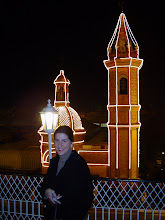Assemble into groups of no more than 3-4. Take a large piece of construction paper and fold into six different sections. Complete the following in the six different sections. Fill up each rectangle and make it visually pleasing using markers and any other materials available to you.
1. Depict what you imagine the Brave New World looks like. You might create a cityscape of London with games, cars, and buildings or you might imagine the inside of the Central London Hatchery and Conditioning Center. Include at least three key terms associated with the setting and one significant quote that would help a reader interpret the scene.
2. Depict Bernard Marx. Surround his portrait with at least five key words or phrases that help us understand his character.
3. Depict the character of Lenina Crowne. Surround her portrait with at least five key words or phrases that help us understand her character.
4. Depict the Savage Reservation. Include at least three key terms associated with the setting and one significant quote that would help a reader interpret the scene.
5. Depict the character of John, the Savage. Surround his portrait with at least five key words or phrases that help us understand his character.
6. Design a new book cover and original title for the novel. Keep it simple, focusing on one or two key concepts from the book.
Sunday, April 20, 2008
Brave New World

Introductory Notes on Brave New World by Aldous Huxley
Novel of ideas: Less emphasis on plot and character development
Satire (a literary work or writing style in which human vice or folly is attacked through irony, derision, or wit. What is Brave New World attacking?
Society functions as a character
Point of View: third person omniscient (all knowing); narrator is not one of the characters and thus has the ability to tell us what is going on within any of the character's minds.
Tone (attitude of the writer): Everything is great! Be aware of the irony here,
questioning the assumptions about the brave new world.
Major Values: Community, Identity, Stability (motto of World State). How are these values achieved?
Setting: London, AF 632 (2540 Current Era)
Utopia: an ideally perfect place, especially in its social, political, and moral aspects
*
From Thomas More's Utopia (1516)
*
Title from the Greek ou or "not" and topos or place, i.e. "no place; a pun on
the Greek eutopia or "happy place"
*
Utopian fiction reveals need for contemporary social reform
Dystopia: an imaginary place or state in which the condition of life is extremely bad, with deprivation, oppression, or terror.
*
Literaly, "bad place"
* In dystopias, an agency or authority (often the government) is frequently shown
to be in total control--the consent of the citizens is irrelevant. There may be
chaos and total social breakdown with no form of social control or security.
Homework: Read Chapter 3 and complete questions from handout. About 3/4 of the way through Chapter 3, you may get confused about who is talking. Huxley uses paragraph breaks to show conversations that are going on simultaneously between Mustapha Mond, the DHC, and the students; Bernard Marx and Henry Foster; Lenina Crowne and her friend Fanny. I suggest highlighting the different sections so you can better follow the dialogue.
Prepare for quiz on Chapters 1-3 and notes for Friday.
Sunday, April 6, 2008
Examining Film Stills
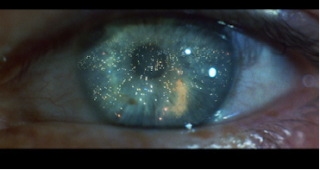
1. The large blue eye. Whose eye is this? Why do you think the film begins with this image?

2. The Tyrell Corporation ziggurat. What might this architecture tell us about the future?

3. The video billboard of Asian woman taking a pill. How might this image relate to Huxley's Brave New World?

4. The neon dragon. How might this image relate to a larger theme in the film?
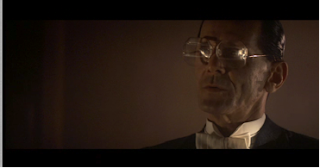

5. Tyrell with glasses and the interior of the Tyrell complex. What themes do these images of Tyrell and his headquarters help support?

6. Bryant's office. How does the interior of Bryant's office compare to Tyrell's headquarters? What other features do you notice?
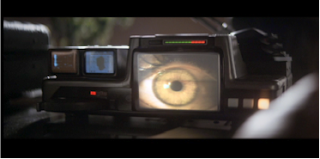
7. Rachael's eye framed by the Voigt-Kampff machine. Why is this image and the voigt-Kampff machine ironic?

8. The picture found in Leon's apartment. Does this image remind you of anything? What are some of the features of the photograph?
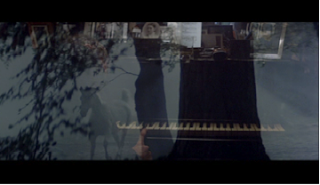

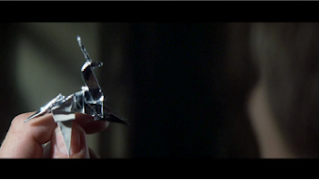
9. Deckard's unicorn dream sequence, the pictures on his piano, and the origami unicorn. What might these images suggest about the character of Rick Deckard?
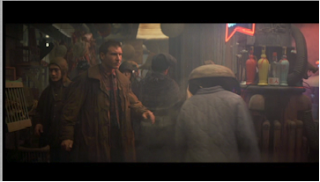
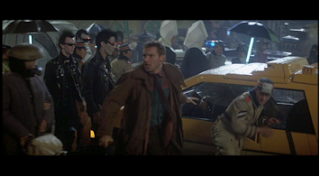
10. Crowded street scenes. What are some of the significant features of the street scenes?
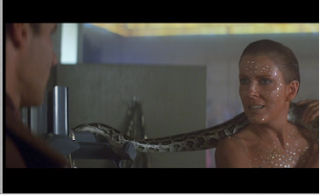
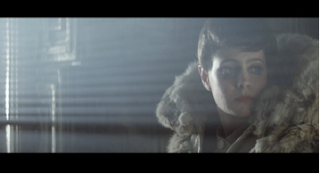

11. Images of Zhora, Rachel, and Pris. What do the depictions of the three female replicants suggest? Brainstorm similarities and differences.
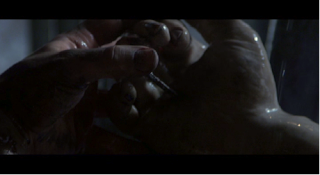
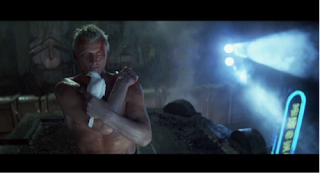
12. Roy Batty's pierced hand and the dove. Why does Roy Batty injure his hand? Why is the dove significant? Why does Roy save Deckard?
Allusions in Blade Runner
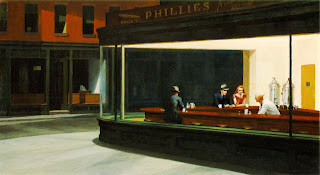
Edward Hopper's "Nighthawks"

Humphrey Bogart in The Maltese Falcon
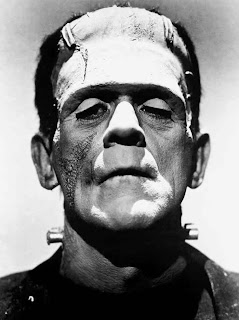
Monster from Frankenstein
Christ on crucifix

Aztec Pyramid
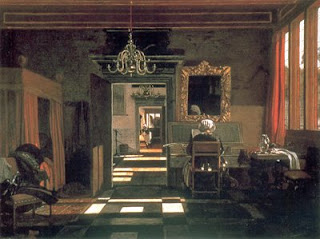
Emanuel de Witte's "Interior with a Woman Playing the Virginals"
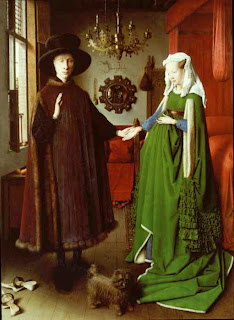
Jan Van Eyck's "The Arnolfini Wedding"

William Blake's poem "The Tyger"
Line from William Blake’s America: A Prophecy
“Fiery the Angels rose while thunder roared around their shores, burning with the fires of Orc.”

Adam and Even in the Garden of Eden
Passage from John Milton’s Paradise Lost (Book I: 61-69)
A Dungeon horrible, on all sides round
As on great Furnace flam’d, yet from those flames
No light, but rather darkness visible
Serv’d only to discover sights of woe,
Regions of sorrow, doleful shades, where peace
And rest can never dwell, hope never comes
That comes at all, but torture without end
Still urges, and a fiery Deluge, fed
With ever-burning Sulphur unconsumed

Unicorn
Blade Runner and Film Noir
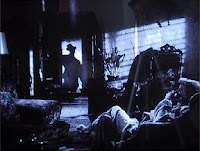
Stylistically, Blade Runner is connected to the tradition of film noir. This term is applied to certain American films during and after World War II that are "dark" in tone. The often intricate narrative generally involve a gruff private detective investigating a crime. Alienated and living out the law, he is driven by his own moral code. Voice over narration (original to the theatrical release of Blade Runner but removed from the 1991 Director's Cut) is common, as is an emphasis on a realistic urban setting and the use of flashbacks. A beautiful femme fatale is commonplace. She might be read as a sexist backlash against the societal shift of the 1940s when women joined the workforce, becoming an unconscious threat to male power.
The aesthetic considerations include chiaroscuro lighting with shadows, silhouettes, and high contrast lighting. Light is accentuated by the smoke wafting from the outlaw characters who drink as much as they smoke. Venetian blinds, fans, and the patterns they create are hallmarks of the lighting design. Unbalanced compositions are also evident, with directorsusing odd camera angles to create interesting frames.
Sunday, March 30, 2008
Film Adaptation and Blade Runner
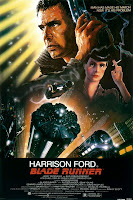
We're now turning our attention to the film Blade Runner, a loose adaptation of PKD's Do Androids Dream of Electric Sheep?. I want us to contemplate what the film does, that the novel does not and vice versa.
The film scholar Dudley Andrew suggests that where literature elaborates a world out of a story, cinema carves a story out of a world. This distinction is fascinating to consider (and the kind of conundrum that PKD might have appreciated). How doe novels and films tell different kinds of stories? Lets consider for a moment the artistic, ideological, and economic issues that arise when works are adapted. Which novels are you familiar with that have been adapted into film? What choices did the director make? Why do you think these choices were made? What were the results?
According to Andrew, there are three primary methods of film adaptation: borrowing, intersecting, and transforming. If we apply these terms to science fiction film, Star Wars can be viewed as a film that "borrows" its basic narrative from the legend of King Arthur, relying on the mythic power of an original source. A sci-film like Solaris "intersects" with an original text, that is "the uniqueness of the original text is preserved to such an extent that it is intentionally left unassimilated in adaptation." The adaptation of H.G. Wells' The Time Machine on the other hand, "transforms" an original source into the medium of film, attempting to remain faithful to the literary experience.
Why is Blade Runner considered such an important sci-fi film? Perhaps its biggest achievement is the creation of a future Los Angeles (versus San Francisco in novel) the that is imaginative and at the same time believable. One scholar, Brooks Landon, suggests thinking about the film as an adaptation that "frames" its antecedent, serving as "a lens for better understanding its source and as a mirror for better studying ourselves." Consider the city of the future. What would your visual design look like?
Viewing Strategies
Consider the literary, dramatic, and cinematic aspects of film.
Literary elements include characterization, theme, and symbolism.
Dramatic elements include mise-en
scene (costume, props, acting)
Cinematic elements include camera angle/movement, light, color, sound, editing, special effects
Playing Detective with Film Allusions
Each of you will receive a textual or pictorial "clue" to the film's meaning. You will conduct research on your clue. What is it? You must complete independent online research. As detectives, you must then write a short report on your clue, prior to viewing the film. After viewing the film you will amend your report providing observations and possible connections to the film. You will then present your findings to the class and lead a discussion on your clue. Scenes can be replayed at this time. Please post your report on your blog and include images or text when appropriate.
Subscribe to:
Posts (Atom)

